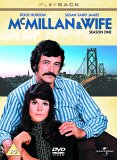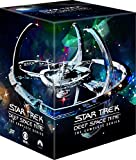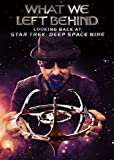![Walker [DVD]](/pictures/1137852.jpg) Walker | DVD | (02/11/2015)
from £5.89
| Saving you £4.10 (69.61%)
| RRP
Walker | DVD | (02/11/2015)
from £5.89
| Saving you £4.10 (69.61%)
| RRP ![Star Trek: Deep Space Nine - Complete [DVD]](/pictures/1108808.jpg) Star Trek: Deep Space Nine - Complete | DVD | (04/07/2011)
from £N/A
| Saving you £N/A (N/A%)
| RRP
Star Trek: Deep Space Nine - Complete | DVD | (04/07/2011)
from £N/A
| Saving you £N/A (N/A%)
| RRP Star Trek: Deep Space Nine is set on a space station orbiting the planet Bajor. Commander Benjamin Sisko is in charge of a diverse crew who must fight off rival alien species who want to control DS9 because of its strategic position close to a wormhole that allows speedy travel to the far reaches of space.
![Where The Buffalo Roam [1980]](/pictures/1013562.jpg) Where The Buffalo Roam | DVD | (05/09/2005)
from £6.98
| Saving you £6.00 (150.38%)
| RRP
Where The Buffalo Roam | DVD | (05/09/2005)
from £6.98
| Saving you £6.00 (150.38%)
| RRP ""I hate to advocate weird chemicals alcohol violence or insanity to anyone... but they've always worked for me."" Bill Murray stars as Hunter S. Thompson the legendary reporter with a sideways way of looking at the news due in part to his love of alcohol and weird chemicals. In his journalistic adventures he covers a free-for-all San Francisco drug trial has a one-on-one bathroom interview with Richard Nixon and gives away his Superbowl tickets so that he can review the g
![Star Trek: Deep Space Nine - Season 3 [1995]](/pictures/1029178.jpg) Star Trek: Deep Space Nine - Season 3 | DVD | (23/06/2003)
from £N/A
| Saving you £N/A (N/A%)
| RRP
Star Trek: Deep Space Nine - Season 3 | DVD | (23/06/2003)
from £N/A
| Saving you £N/A (N/A%)
| RRP Deep Space Nine's third series begins eventfully, with Sisko promoted to captain and being gifted a prototype warship equipped with a cloaking device, while Odo learns where he came from. In the two-part opening tale, this clever gambit is played to hook viewers into the idea of DS9 becoming an ongoing mystery/conflict show. Why the sudden intense format tweaking? Mostly this was to ensure the show continued to thrive when a really rather greedy production hierarchy fast-tracked Voyager onto the air mid-season (cue unnecessary crossover episode with Tuvok). Of greater concern was ratings thief Babylon 5, which played its counter-Trek cards at precisely the right time. Fortunately the result (initially at least) was a genuine boost for DS9. Cast members seemed to have hit their stride and played off one another more assuredly than before. For example, Odo's character took several additional interesting twists, especially in his relationship with Kira. Rene Auberjonois had a very good year, directing two episodes to boot. Avery Brooks had begun this trend with the previous year's penultimate show. The real surprise was seeing Jonathan Frakes's name working behind the camera on three occasions, because he also appeared on screen in his alternate rogue Riker role, when Thomas dramatically steals the Defiant. Other welcome cameos that aided the feeling of casual camaraderie included the return of Lwaxana Troi, as well as first appearances by Quark's Mum, the spooky Founder Leader, the lovely Leeta and the sneaky Eddington. Clint Howard--a cult Trek figure--was briefly welcomed back, and with the many faces of Jeffrey Combs another was born. Stories progressed the complicated Bajoran/Cardassian healing process, while simultaneously brewing potential conflicts far worse than the behind-the-scenes ratings war. --Paul Tonks
 McMillan And Wife - Season 1 | DVD | (25/09/2006)
from £N/A
| Saving you £N/A (N/A%)
| RRP
McMillan And Wife - Season 1 | DVD | (25/09/2006)
from £N/A
| Saving you £N/A (N/A%)
| RRP San Francisco attorney Stewart MacMillan is named commisioner of the San Francisco police department. With his pretty but somewhat kooky wife Sally his hard drinking housekeeper Mildred and his assistant the somewhat dimwitted Seargent Charlie Enright Mac manages to solve some of San Francisco's most baffling crimes... Episodes Comprise: 1. Murder By The Barrel 2. The Easy Sunday Murder Case 3. Husbands Wives Killers 4. Death Is A Seven Point Favourite 5. The Face Of Murder 6. Til Death Do Us Part 7. An Elementary Case Of Murder
![The Little Mermaid [1989]](/pictures/1010242.jpg) The Little Mermaid | DVD | (24/03/2000)
from £14.97
| Saving you £5.02 (33.53%)
| RRP
The Little Mermaid | DVD | (24/03/2000)
from £14.97
| Saving you £5.02 (33.53%)
| RRP From the moment that Prince Eric's ship emerged from the fog in the opening credits of The Little Mermaid in 1989 it was apparent that Disney had somehow, suddenly recaptured a "magic" that had been dormant for 30 years. In the tale of a headstrong young mermaid who yearns to "spend a day, warm on the sand", Ariel trades her voice to Ursula, the Sea Witch (classically voiced by Pat Carroll), for a pair of legs. Ariel can only succeed if she receives true love's kiss in a few day's time and she needs all the help she can from a singing crab named Sebastian, a loudmouth seagull and a flounder. The lyrics and music by song-writing team Howard Ashman and Alan Menken are top form: witty and relevant, and they advance the story (go on, hum a few bars of "Under the Sea"). Mermaid put animation back on the studio's "to do" list and was responsible for ushering 1991's Beauty and the Beast into cinemas. A modern Disney classic. --Keith Simanton
 The Christmas Star | DVD | (02/10/2006)
from £8.96
| Saving you £6.03 (67.30%)
| RRP
The Christmas Star | DVD | (02/10/2006)
from £8.96
| Saving you £6.03 (67.30%)
| RRP Disney gives families a gift full of the spirit of the season as Ed Asner plays Horace McNickle a counterfeiter who escapes prison through his extraordinary likeness to St. Nick. The Police are closing in but Christmas is near so there are redsuited ones everywhere. McNickle is desperate to recover loot from an earlier caper and can't make a move until he takes advantage of two neighborhood kids who really believe he is Santa. After the kids come through it dawns on him that he has always missed the true meaning of the holidays. rather than make good on his escape he tries to make good on his promises.
 Star Trek: Deep Space Nine: The Complete Series | DVD | (07/02/2017)
from £39.99
| Saving you £N/A (N/A%)
| RRP
Star Trek: Deep Space Nine: The Complete Series | DVD | (07/02/2017)
from £39.99
| Saving you £N/A (N/A%)
| RRP ![Star Trek: Deep Space Nine - Season 6 [1995]](/pictures/1029131.jpg) Star Trek: Deep Space Nine - Season 6 | DVD | (08/12/2003)
from £N/A
| Saving you £N/A (N/A%)
| RRP
Star Trek: Deep Space Nine - Season 6 | DVD | (08/12/2003)
from £N/A
| Saving you £N/A (N/A%)
| RRP Deep Space Nine's sixth series began ambitiously with a six-part story arc devoted to the Dominion War. This was a brave move in many ways, but a sensible one too. Whereas other SF shows wouldn't commit to showing the impact of war (Babylon 5), here there were numerous visible sacrifices. Characters were frequently kidnapped and held prisoner, allowing screen time for other members of the ever-growing cast (at its peak there were as many as 18 individuals with speaking roles per episode). This year also introduced the idea of Starfleet Intelligence and its sinister Section 31; alliances were built only to crumble almost immediately; Sisko led a suicide mission and at long last his destiny as the Emissary took a serious turn. Amid all this sturm und drang the writers felt it necessary to inject some levity. In fact, there was so much comedic sidetracking this year it actually seemed sometimes as if they were afraid of the series dark tone. Witness: Quark undergoing a temporary sex change, leading a Magnificent Seven-style band of Ferengi (with a cameo from Iggy Pop), Morn's non-speaking character being sorely missed, the blend of Troi and Guinan into 60's crooner Vic Fontaine and, in one fan favourite episode ("Far Beyond the Stars"), Sisko having visions of himself and the crew as 1950s staff writers on pulp magazine Incredible Tales. There were also cute reconciliations amongst Worf's extended family (leading to Trek's first cast wedding), and even the revelation of Bashir's genetically enhanced origins quickly became a subject for easy jokes. Any of these events would have been satisfactorily cute if the war had ended and the show had moved on. But confusing the viewer, every so often the battle would be rejoined mid-episode. The clinching proof that no grand design was really at work was in the sudden and brutal dispatch of Dax. Actress Terry Farrell gave sufficient forewarning of having had enough of the show, but specifically asked not to be killed off. Despite all the jarring humour scattered about after the strong opening, the show seemed unable to avoid reverting to shock tactics for its finale. All of which hardly made the promised final year seem a particularly enticing prospect. --Paul Tonks
![Fear And Loathing In Las Vegas / Where The Buffalo Roam [1998]](/pictures/1013563.jpg) Fear And Loathing In Las Vegas / Where The Buffalo Roam | DVD | (05/09/2005)
from £19.90
| Saving you £0.09 (0.45%)
| RRP
Fear And Loathing In Las Vegas / Where The Buffalo Roam | DVD | (05/09/2005)
from £19.90
| Saving you £0.09 (0.45%)
| RRP Fear And Loathing In Las Vegas (Dir. Terry Gilliam 1998): (Widescreen 2.35 Anamorphic / Dolby Digital 5.1) It is 1971: journalist Raoul Duke barrels towards Las Vegas to cover a motorcycle race accompanied by a trunkful of contraband and his slightly unhinged Samoan attorney Dr. Gonzo. But what is ostensibly a cut-and-dry journalistic endeavor quickly descends into a feverish psychedelic odyssey and an excoriating dissection of the American way of life. Director Terry Gi
![Star Trek: Deep Space Nine - Season 7 [1995]](/pictures/1029129.jpg) Star Trek: Deep Space Nine - Season 7 | DVD | (22/12/2003)
from £N/A
| Saving you £N/A (N/A%)
| RRP
Star Trek: Deep Space Nine - Season 7 | DVD | (22/12/2003)
from £N/A
| Saving you £N/A (N/A%)
| RRP The seventh and final series of Deep Space Nine came down to loose ends, tying some existing ones together and allowing others to unravel. Symptomatic of the unwillingness to let DS9 go was the immediate arrival of a replacement Dax, though poor Nichole deBoer as Ezri Dax had to have known she'd already missed the boat. Her appearance encouraged last-minute romances to blossom, with Bashir finally getting some action, Odo finally getting together with Kira and Sisko finally proposing to Kassidy. Another contributing cute factor were numerous trips to the Holosuite wherein the all-knowing Vic Fontaine dished out philosophical advice. That was when the crew weren't in there to play baseball against the Vulcans or when Nog wasn't commiserating about the loss of a leg. Oh yes, and don't forget the war! There was an early announcement that the show would attempt a 10-part resolution to the Dominion War, but viewers could be forgiven for forgetting all about it with so much sentimental distraction. When the horrors of war did resurface, they at least injected a few surprises into the mix. Odo and his ambiguously "evil" Founders were hit with a melting disease, prompting a backstabbing race for the power of developing and owning a cure. The original baddie Cardassians finally settled on the Federation's side. Contrary to these interesting twists, however, were the unexpected turns taken by matters relating to Sisko's spiritual destiny. Suddenly the mystery of the wormhole and an entire religious belief system was reduced to the problem of translating correctly the words of a sacred book. The struggle to join with some evil aliens significantly diluted the attempt at resolving what had begun seven years before in the show's pilot episode. Ultimately, Sisko's destiny, as with all those who'd followed him to the open-ended climax, was to be decided elsewhere. In a move that was either bold and daring--or possibly born of desperation for not having thought things through properly--the show's storylines were to be continued in a series of spin-off books. --Paul Tonks
 The Lost Language of Cranes | DVD | (18/06/2007)
from £12.97
| Saving you £0.02 (0.20%)
| RRP
The Lost Language of Cranes | DVD | (18/06/2007)
from £12.97
| Saving you £0.02 (0.20%)
| RRP When a young gay may comes out of the closet his friends support him. However when he comes out to his parents he stirs up a wealth of hidden feelings and secrets in their relationship.
![Walker [1987]](/pictures/1019070.jpg) Walker | DVD | (07/07/2003)
from £N/A
| Saving you £N/A (N/A%)
| RRP
Walker | DVD | (07/07/2003)
from £N/A
| Saving you £N/A (N/A%)
| RRP William Walker (Harris) and his mercenary corps enter Nicaragua in the middle of the 19th century in order to install a new government by a coup d'etat...
 An American Tale: The Treasure Of Manhattan Island | DVD | (05/12/2005)
from £2.89
| Saving you £7.10 (245.68%)
| RRP
An American Tale: The Treasure Of Manhattan Island | DVD | (05/12/2005)
from £2.89
| Saving you £7.10 (245.68%)
| RRP Fievel the Mouse returns in the third installment in the An American Tail series. Fievel (voice of Thomas Dekker) and his friend Tony Toponi find a map that they believe points to a treasure buried somewhere beneath Old New York and the plucky rodent is determined to find it. However what he discovers under the city is a tribe of Native American mice who were driven underground by prejudiced European immigrants. Fievel makes new friends with the outcasts and he comes to realize tha
![Star Trek: Deep Space Nine - Season 5 [1995]](/pictures/1029140.jpg) Star Trek: Deep Space Nine - Season 5 | DVD | (27/10/2003)
from £N/A
| Saving you £N/A (N/A%)
| RRP
Star Trek: Deep Space Nine - Season 5 | DVD | (27/10/2003)
from £N/A
| Saving you £N/A (N/A%)
| RRP Deep Space Nine's fifth series was a turning point from which there was no going back. Character and information overload took over, and the complicated twists and turns in the build up to war either hooked viewers securely, or sent them away with a headache. The Klingon faction instigated by Worf's arrival was occasionally played for laughs, but mostly their hard-headed personalities made all efforts at diplomacy moot. In the opening episode a chilling possibility is proposed as to why might be: have the Changelings infiltrated already and replaced key personnel? Some fans saw this as a flawed X-Files-style development. Nevertheless it sowed a seed of insidious suspicion from here on, affecting all the principal casts' relationship with one another, even allowing Odo and Quark an opportunity to confess a degree of friendship. Expanding on the new theme of duplication, the crew also made numerous trips to their Mirror Universe counterparts. As well as new uniforms and the milestone 100th episode, Nana Visitor and Alexander Siddig comically got to disguise the arrival of their child during filming. More laughs came from the fan favourite "Trials and Tribble-ations" with CG allowing Sisko and crew to interact with Kirk and a cameo from Leonard Nimoy. Avery Brooks began taking a backseat as of this year, partly a result of the now-overcrowded cast. Although Sisko's destiny would be foreshadowed by his first vision and the introduction of the Pah-wraiths, the Captain was in an increasingly sulky mood. Brooks only directed one episode, allowing room for regulars LeVar Burton and Rene Auberjonois to do more behind the camera. Joining them were Alexander Siddig, Michael Dorn and even Andrew Robinson. Available space started to seem hardly deep enough. --Paul Tonks
![Mccabe And Mrs Miller (Hmv Exclusive) - The Premium Collection [Blu-ray]](/pictures/1164932.jpg) Mccabe And Mrs Miller (Hmv Exclusive) - The Premium Collection | Blu Ray | (09/04/2018)
from £N/A
| Saving you £N/A (N/A%)
| RRP
Mccabe And Mrs Miller (Hmv Exclusive) - The Premium Collection | Blu Ray | (09/04/2018)
from £N/A
| Saving you £N/A (N/A%)
| RRP  King Kong/King Kong Lives | DVD | (01/01/2007)
from £N/A
| Saving you £N/A (N/A%)
| RRP
King Kong/King Kong Lives | DVD | (01/01/2007)
from £N/A
| Saving you £N/A (N/A%)
| RRP King Kong: The Legend Reborn (1976) Fred Wilson (Charles Grodin) head of an oil drilling expedition to the remote island of Micronesia discovers a stow-away on his ship Jack Prescott (Jeff Bridges) a zoologist in search of a prehistoric creature fabled to exist on the island. Off the coast of Micronesia they rescue Dwan (Jessica Lange) a beautiful woman shipwrecked in the treacherous seas. On the island the expedition witness a mysterious ritual to a strange beast called Kong. They soon realise that Kong is the gigantic ape that Prescott is searching for... Producer Dino De Laurentiis' remake of the original hairy monster movie features remarkable special effects by Rick Baker. King Kong Lives! (1986) The mighty ape is resurrected through a miracle of modern medicine and brings him together with what will be the equally terrifying love of his life: Lady Kong... This version of the classic story picks up from where the 1976 version left off.
![The Little Mermaid/the Little Mermaid II (Disney) [Box Set]](/pictures/1051959.jpg) The Little Mermaid/the Little Mermaid II (Disney) | DVD | (06/11/2006)
from £N/A
| Saving you £N/A (N/A%)
| RRP
The Little Mermaid/the Little Mermaid II (Disney) | DVD | (06/11/2006)
from £N/A
| Saving you £N/A (N/A%)
| RRP The Little Mermaid: Disney's 28th animated masterpiece. Awash with breathtaking animation unforgettably colourful characters and two Academy Awards for score and song ""Under The Sea "" The Little Mermaid is one of Disney's most cherished films. Ariel the fun-loving and mischievous mermaid is enchanted with all things human. Disregarding her father's order to stay away from the world above the sea she swims to the surface and in a raging storm rescues the prince of her dreams. Determined to be human she strikes a bargain with the devious sea witch Ursula and trades her fins and beautiful voice for legs. With her best friend the adorable and chatty Flounder and her reluctant chaperone Sebastian the hilarious reggae-singing Caribbean crab at her side Ariel must win the prince's love and save her father's kingdom -- all in a heart-pounding race against time! The Little Mermaid II - Return To Sea: After rejoicing over the birth of their daughter Melody Ariel and Eric must face a new threat from Ursula's revengeful sister Morgana - a threat that forces them to hide Melody's true mermaid heritage. Melody a young princess curious about her roots ultimately ventures into the sea against her parents' wishes. There she meets new friends and in her dreams to be a mermaid becomes a pawn in Morgana's plot to gain control of the Seven Seas. Ariel must reunite with her childhood friends Sebastian Flounder and Scuttle to rescue her daughter and restore harmony to the family.
 What We Left Behind: Looking Back at Star Trek: Deep Space Nine | DVD | (06/08/2019)
from £N/A
| Saving you £N/A (N/A%)
| RRP
What We Left Behind: Looking Back at Star Trek: Deep Space Nine | DVD | (06/08/2019)
from £N/A
| Saving you £N/A (N/A%)
| RRP ![Star Trek: Deep Space Nine - Season 1 [1995]](/pictures/1029211.jpg) Star Trek: Deep Space Nine - Season 1 | DVD | (24/03/2003)
from £N/A
| Saving you £N/A (N/A%)
| RRP
Star Trek: Deep Space Nine - Season 1 | DVD | (24/03/2003)
from £N/A
| Saving you £N/A (N/A%)
| RRP Of all the spin-off TV incarnations of Star Trek, Deep Space Nine had the hardest job persuading an audience to watch. By all accounts, Gene Roddenberry had concerns about the idea before his death in 1991. It took two more years to develop, and when it finally aired in 1993 reasons for that concern were evident right away. The show was dark (literally), characters argued a lot, no one went anywhere and the neighbouring natives were hardly ever friendly. Yet for all that the show went against the grain of The Great Bird's original vision of the future, it undeniably caught the mood of the time, incorporating a complex political backdrop that mirrored our own. In the casting, there was a clear intent to differentiate the show from its predecessors. Genre stalwarts Tony Todd and James Earl Jones were considered for Commander Sisko before Avery Brooks. The one let down at the time was that Michelle Forbes did not carry Ensign Ro across from TNG, but when the explosive Nana Visitor defiantly slapped her hand on a console in the pilot episode, viewers knew they were in for a different crew dynamic. In fact, the two-part pilot show ("The Emissary") is largely responsible for DS9's early success. Mysterious, spiritual, claustrophobic, funny and feisty, it remains the most attention-grabbing series opener (apart from the Classic original) the franchise has had. The first year may have relied on a few too many familiar faces--like Picard, Q and Lwaxana Troi--but these were more than outweighed by refreshingly detailed explorations of cultures old and new (Trill, Bajoran, Cardassian, Ferengi). As it turned out, Deep Space Nine was the boldest venture into Roddenberry's galaxy that had been (or ever would be) seen. On the DVD: Star Trek Deep Space Nine, Series 1's hour of special features is split between seven featurettes that really would have worked better edited together. Covering the show's origins and most aspects of Year One's production design, they all crib from interviews with actors and crew from the 1992 shoot (exclusively so in the 10 "Hidden Files"). Other interviews conducted in 1999 and 2002 tend to be more revealing, although the solo section on Major Kira is curiously lacking in recent input. While the designers describe their work with passion, creators Michael Piller and Rick Berman come off as stiff and lacking in knowledge. Hopefully this is something that will improve through the next six box sets. The interactive CD-ROM to build a DS9 database on your PC is something that will become more involving, too. Obviously the most important thing is the episodes themselves, and despite the lack of a commentary to enhance the best of them, sound in 5.1 and the crisp full-frame picture do them ample justice. --Paul Tonks END

Please wait. Loading...
This site uses cookies.
More details in our privacy policy